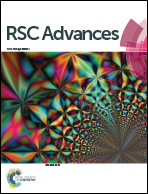Fluorinated amphiphilic block copolymers via RAFT polymerization and their application as surf-RAFT agent in miniemulsion polymerization†
Abstract
This investigation reports the preparation of amphiphilic block copolymer (Am-BCP) based on poly(ethylene glycol) methyl ether methacrylate (PEGMA) and 2,2,3,3,4,4,4-heptafluorobutyl acrylate (HFBA) via RAFT polymerization. In this case poly(PEGMA) (PPEGMA) was prepared using 2-cyano-2-propyl dithiobenzoate (CPBT) as a RAFT agent. This PPEGMA was later used as a macro-RAFT agent for the polymerization of HFBA to prepare well-defined block copolymers (BCPs), (PPEGMA-b-PHFBA) of varied lengths and compositions. The BCPs self-assembled in aqueous solution to produce spherical micelles consisting of hydrophobic block PHFBA as a core and a hydrophilic block of PPEGMA as a flexible corona. This Am-BCP formed micelles of different sizes, as characterized by dynamic light scattering (DLS) and TEM analyses. The Am-BCP was later used as a surf-RAFT agent i.e. as a surfactant as well as a macro-RAFT agent for the miniemulsion polymerization of styrene. TEM analysis showed that the synthesized polystyrene emulsion had a core–shell morphology. The particle size and particle size distributions of the polystyrene latex were determined by DLS analysis.


 Please wait while we load your content...
Please wait while we load your content...